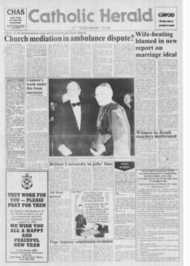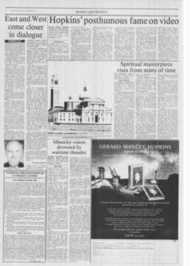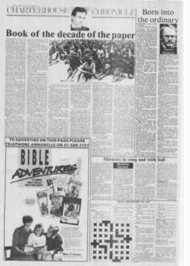Page 3, 29th December 1989
Page 3

Report an error
Noticed an error on this page?If you've noticed an error in this article please click here to report it.
Tags
Share
Related articles
A Two-way Channel Reflecting Both Sides Of Council Coin
Love Rather Than Law In The Seventies
Whitetriars Fltrotticie
New Order Will Depend Onl Right Relationship Between...
Glastonbury
A turbulent decade for the Church
We begin three pages of pictures and text looking back at the 1980s and forward to the 1990s with a brief re-run of the major events in the life of the church in the past ten years
FOR the Catholic Church, the 1980s were a decade of transition from the turbulent years after Vatican II to a new identity, shaped in large part by the powerful personality and world view of Pope John Paul Amid the world of violence, injustice and conspicuous consumption alongside devastating poverty, Catholic and other religious leaders were a voice for peace, justice and spiritual values.
Quite apart from the interplay of church and world that occupied the major energies of religious people everywhere, however, the 1980s were also a period of significant internal change within the Catholic Church and other religious bodies as they tried to grapple with new issues, trends and jaersonalities.
In the world at large, one of the most notable religious stories of the decade was the resurgence of Islam, led by the establishment in 1979 of Ayatollah Ruhollah Khomeini's Islamic revolutionary government in Iran. before the ayatollah died in 1989, the fundamentalist fervour he encouraged had wider impact around the world.
One of the highlights of the decade in ecumenical and interfaith relations was Pope John Paul's 1986 invitation to world religious leaders to gather in Assisi, Italy, birthplace of St Francis of Assisi, to pray side by side for world peace. The October 27 day of prayer brought together 150 religious leaders — Catholic, Protestant. Orthodox, Jewish, Moslem, Buddhist, Hindu. African Animist, American Indian and others — from all parts of the world.
Within the Catholic Church, largest of all Christian bodies, Pope John Paul embarked on a campaign throughout the decade to re-establish a firm footing in traditional moral and religious doctrine after an era marked by questioning and dissent. His chief guardian of faith and morals, Cardinal Joseph Ratzinger of the Congregation for the Doctrine of the Faith, was frequently in the news as an outspoken critic of theological opinions at variance with official church teachings.
The 1970s phenomenon of priests and religious in politics — seen by the Pope as undermining their proper religious mission — was sharply curtailed in the early 1980s. In 1980 the two US priests in Congress — Jesuit Fr Robert Drinan of Massachusetts and Norbert ine Fr Robert Cornell of Wisconsin — announced they would not seek re-election that autumn. Similar withdrawals occurred in others parts of the world. In Nicaragua three priests were suspended for refusing to leave their government posts.
Less than two weeks beforts the start of the decade, Swiss7 born German theologian Fr Hans Kung was declared ineligible to teach as a Catholic theologian. In 1986 US moral theologian Fr Charles Curran received the same verdict.
Brazilian Franciscan theologian Fr Leonardo Boff, a leading proponent of liberation theology, was silenced for a year. US Dominican Fr Matthew Fox, a creationist theologian, received a similar restriction.
The Imprimatur, or official church permission to publish, was withrawn in April 1984 from Anthony Wilhelm's Christ Among Us, one of the most popular catechisms for adults in the United States. A few days later it was also withdrawn from Sulpician Fr Philip Keane's Sexual Morality.
Strong statements by the Vatican on the binding and authoritative character of specific moral teaching coupled with controversial appointMents of bishops and alleged intervention to prevent teaching appointments of some theologians provoked a large group of German theologians in January 1989 to issue the "Cologne Declaration". Theologians in several other countries followed suit.
Critics of the Pope accused him of abusing his authority, overcentralising the Church and suppressing legitimate diversity in theological thinking.
Supporters said the Pope was restoring a much-needed emphasis on authentic church teaching. They described his actions as putting the Church back on the course of its central mission after a long period in which dissent and argument had left many Catholics without a sense of direction.
Among the Pope's efforts to revive the spiritual life of Catholicism were the calling of a special holy year of reconciliation in 1983, marking the 1,950th anniversary of the traditional year of Christ's death, and the establishment of a special year of devotion to Mary in 1987-88.
Despite his efforts to halt departures from approved church practices, Pope John Paul was still too liberal for French Archbishop Marcel Lefebvre, leader of a traditionalist movement that opposed liturgical reforms since the second Vatican Council and concilliar teachings on religious liberty and ecumenism. In 1988 the ageing archbishop culminted years of dissent by ordaining four new bishops. He was immediately excommunicated.
In an effort to reconcile Lcfebvrites who wished to remain in union with the Church, the Pope established a special commission that could offer limited concessions, including permission for use of the preVatican II form of the Mass.
Despite complaints of more centralised power in Rome under Pope John Paul, the Pope has been noted for his support of bishops' conferences especially during his 44 trips abroad 40 of them in the 1980s.
When problems arose between his central staff the Roman curia — and the bishops of a country. he convened a
sielsealioe t. that nation's bishops in Rome to meet with
him and top Vatican officials in order to develop better mutual understanding. Three such meetings took place: with 21 Brazilian bishops in 1986, with 34 US prelates in spring 1989 and with 22 West German bishops in autumn 1989.
The world synods of bishops held in the 1980s reflected the Pope's concern to revitalise the Church', sense of its mission. Building on the 1974 and 1977 synods under Pope Paul VI, at which representatives of the world's bishops addressed evangelisation and catechetics respectively, the synods of the 1980s dealt with: • family life in 1980, reflecting on the importance of the family as the place of growth in Christian belief and commitment.
• reconciliation in 1983, concentrating on both the sacraments of penance and the need for forgiveness and "reconciliation in general as a basic element of Christian life.
• a review in 1985 of church renewal in the 20 years since the end of Vatican II. The special synod meeting, consisting chiefly of the presidents of national bishops' conferences, called for the development of a new universal Catholic catechism and deeper study of collegiality, authority and decision-making in the Church, with special emphasis on the role of bishops' conferences.
• laity in the Church and the world in 1987, with the aim of developing lay spirituality and encouraging lay people to contribute more fully to the total mission and witness of the Church in the world.
The new Code of Canon Law, which the Pope published in 1983, emphasised the role of all baptised people in carrying out the Church's mission. The new code, the product of 20 years' work to revamp the Church's 1917 code, reflected and consolidated extensive changes since Vatican II. Key elements in the legislative reform were a shift from a legalistic to a sacramental mentality throughout the code, substantial decentralisation of church authority, significantly broadened definitions of lay rights and responsibilities within the Church, and elimination of virtually all laws that treated laywomen differently from laymen.
While women found greater equality with men in many areas of church discipline and practice in the 1980s, their continued exclusion from priestly ordination was a source of tension and conflict in the United States and other countries.
The ordination of women in some non-Catholic denominations, while Catholics and the Orthodox found themselves unable to accept the practice, came increasingly to the fore in ecumenical discussions as an obstacle to Christian unity. New attention was drawn to the issue in 1988 when the Lambeth Conference, a gathering of world Anglican leaders, urged member churches to respect one atiother's decisions to ordain or not ordain women, and in 1989 when the US Episcopal Church ordained the first woman bishop in the Anglican communion.
Controversy frequently surrounded attemps by the Pope and Vatican officials to reaffirm Catholic moral teaching on matters of sexuality and procreation.
A 1986 document from the Congregation for the Doctrine of the Faith condemning all homosexual activity and warning church personnel to distance themselves from the "pro -homosex u al movement" led several US dioceses to halt masses for Dignity, an unofficial Catholic homosexual organisation. Dignity became more outspoken in its calls for a change in church teaching on homosexual orientation and activity.
A 1987 doctrinal congregation document challenged many rapidly expanding fields of procreative technology, insisting that the integral bond between the conjugal act and human reproduction cannot be separated morally. Among practices condemned were artificial insemination, in vitro fertilisation, surrogate motherhood, non-therapeutic experimentation with embryos or fetuses, and discarding of embryos in technological reproduction.
In a series of Wednesday general audience talks in 1984 the Pope forcefully reaffirmed church teaching against artificial birth control. Four years later, church-backed international symposiums and other activities observing the 20th anniversary of Pope Paul VI's Humanae Vitae marked a new assault by church officials on what it called the contraceptive mentality.
Pope John Paul published six encyclicals during the 1980s: Rich in Mercy in 1980, On Human Work in 1981, The Apostles of the .Slavs in 1985, Lord and Giver of Life in 1986 and The Mother of the Redeemer and On Social Concerns in 1987.
Other major Vatican statements on issues of doctrine, morality and church life in the 1980s included: • .from the doctrinal congregation, a 1980 declaration on euthanasia and two instructions in 1984 on various aspects of liberation theology.
• from the Pontifical Justice and Peace Council. documents on Third World debt in 1987, homelessness in 1988 and racism in 1989.
• from the Congregation for Catholic Education, guidelines in 1983 for sex education.
• from the Pontifical Council for Social Communications, a 1989 document on violence and pornography in the media.
• from the Pontifical Council for Promoting Christian Unity, a 1986 statement on sects and new religious movements.
Catholic-Jewish relations suffered several setbacks during the decade as world Jewish leaders protested at papal meetings with Palestine Liberation Organisation leader Yasser Arafat and Austrian President Kurt Waldheim. Jews also objected to church delays in moving a Polish convent from the Nazi death camp at Auschwitz. Despite the difficulties, dialogue continued and some advances in CatholicJewish understanding were achieved.
Catholic-Lutheran and Catholic-Anglican relations advanced in the 1980s with important new theological agreements. The Vatican also gave a generally positive response to Baptism, Eucharist and Ministry, a 1982 document on basic issues of Christian unity produced under the auspices of the Faith and Order Commission of the World Council of Churches.
Catholics and mainline Protestant bodies expressed growing concern in the 1980s over proselytism by fundamentalist churches. But fundamentalists also suffered setbacks as two of their television preaching Stars, the Revs Jim Bakker and Jimmy Swaggart, were involved in sex scandals.
Throughout the decade the Holy See was beleaguered by yearly deficits in the millions. Bishops sought major increases in Catholic contributions around the world to reverse the deficits. The Vatican Bank was indirectly involved in dealings that brought on the 1982 collapse of Italy's largest private batik in one of the largest international banking scandals of the decade. The Vatican Bank denied any guilt in the affair but in 1984 gave Italy nearly S250 million to resolve the matter.
In the United States, the National Conference of Catholic Bishops in the 1980s gained new respect as a major international moral voice, as the bishops developed a new style of
consultation in the writing of national pastoral !eters. The new
style started with their 1983 peace pastoral, which was preceded by two years of extensive consultation with leading US theologians, scientists and experts in defence, disarmament and diplomacy as well as meetings with the Vatican and European bishops.
blog comments powered by Disqus











